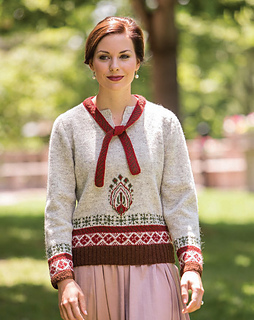patterns > Piecework >  The Unofficial Downton Abbey Knits 2014 and 1 more...
The Unofficial Downton Abbey Knits 2014 and 1 more...
> Tour-the-Estate Paisley Slipover





Tour-the-Estate Paisley Slipover
Interweave SKU: EP11495
Finished Size: 38½ (42½, 44) inches (97.8, [108.0, 111.8] cm) bust circumference
Yarn: Jamieson’s Shetland Spindrift, 100% Shetland wool, fingering weight, 115 yards (105.2 m)/25 gram (0.9 oz) ball, 10 (11, 12) balls of #127 Pebble (Color A), 2 (3, 3) #587 Madder (Color C), and 1 ball of #815 Ivy (Color D)
Yarn Weight: #2 - Fine
Needles: Straight, sizes 2 (2.75 mm) for body and 3 (3.25 mm) for borders or size needed to obtain gauge
Notions: Crochet hook size E/4 (3.5 mm); stitch markers; stitch holders; tapestry needle
Gauge: 28 sts and 40 rows = 4 inches (10.2 cm) in St st on smaller needles; 28 sts and 33 rows = 4 inches (10.2 cm) in Border Chart patt on larger needles
Originally Published: Unofficial Downton Abbey Knits 2014
This fine-gauge, pure Shetland wool slipover is an adaptation of a knitted garment in a 1923 Columbia Yarn Book. Stranded colorwork or argyle work became popular for sportswear during the early 1920s, perhaps because the Prince of Wales, the future King Edward VIII (1894–1972), was frequently seen wearing argyle sweaters when playing golf.
The original garment was knitted from the bottom of the back, up and over the shoulders to the bottom of the front. The armholes were picked up to knit the sleeves from top to bottom. The method minimized seams and allowed easy alteration of the length of the body and sleeves. However, the stitches in colorwork patterns are V-shaped when knitted from bottom to top but tent-shaped when viewed upside down as they would appear on the front of the one-piece garment. The narrow knitted tie is an attached accessory.
Patterns in 1923 offered only yarn name and needle size for one size of garment; gauge, yarn ball size, yardage, and shape schematics were up to the knitter. Some things are timeless, however, such as this tip in the Columbia Yarn Book: “To sew up a knitted or crochet garment neatly is half the battle toward giving it a well-tailored appearance. The seams should be laid together stitch for stitch or row for row and 1 strand only picked up from each side. More than this makes a lumpy, heavy seam. A blunt-pointed tapestry needle is the best for this work.”
32136 projects
stashed
56696 times
- First published: September 2014
- Page created: September 22, 2014
- Last updated: January 14, 2023 …
- visits in the last 24 hours
- visitors right now




